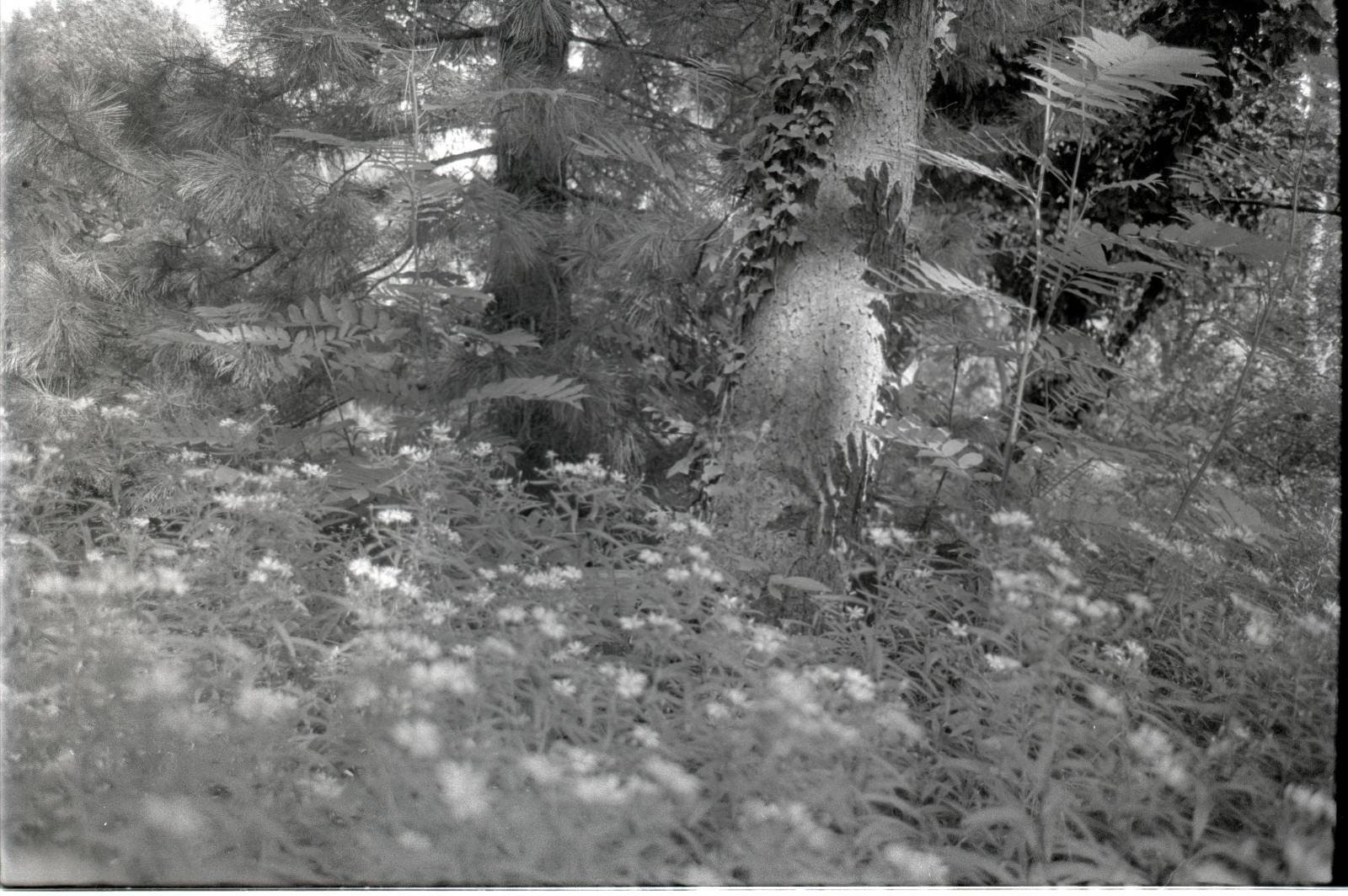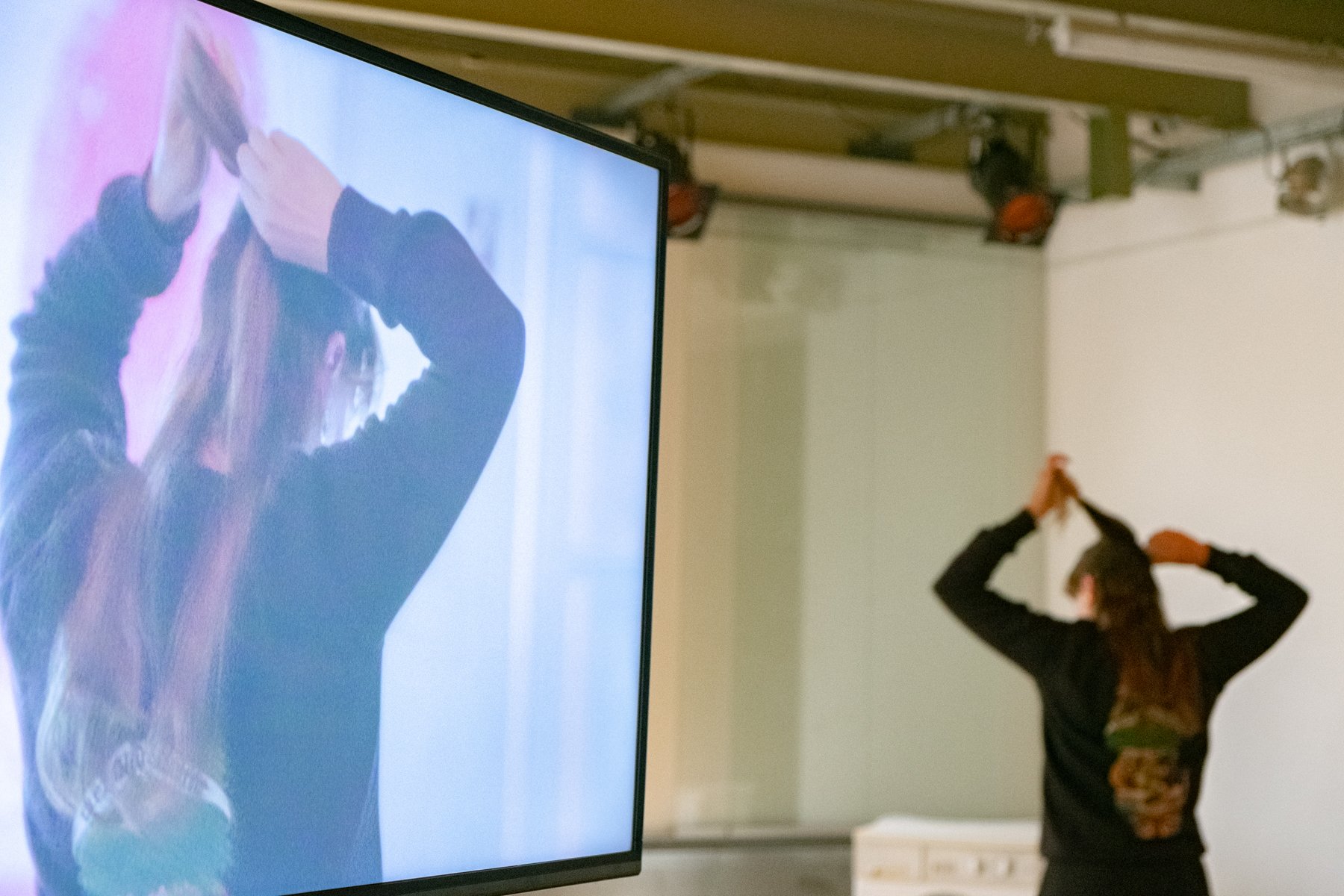
What's so scary about a falling tree
What's so scary about a falling tree
Collective listening & discussion
Kata Bitowt, Martyna Šulskutė
Audio story, 23’42’’
2022
Society by definition is the aggregate of people living together in a more or less ordered community. What if we were to broaden these boundaries to other species? Living in a capitalist economy, our culture is innately anthropocentric, constantly expanding our influence and power over the natural world, controlling the resources and deciding about the habitats of others.
What would we gain from another type of expansion? Expansion of perception, including other kingdoms of life into our society?
After a listening session of the piece 'What's so scary about a falling tree', we invite you to a further discussion with one of the episode's interlocutors, botanist Dr. Radvilė Rimgailė-Voicik.
We will further discuss the topics of broadening our concept of 'society', if we should or shouldn't compare animals and plants, why are we prone to categorise and label everything, and can we escape language?
Dr. Radvilė Rimgailė-Voicik - botanist, a researcher at Life Sciences Center, Vilnius University. Lecturing about plant diversity and its importance. Curious to learn and share challenging ideas about vegetal life.
Kata Bitowt is a sound producer and recording engineer based in Vilnius. Her main interest is in the music-noise-sound boundaries and how they can be manipulated. She creates electroacoustic compositions and audio stories, which is a great place to combine field recordings with synthetic sounds and sterility of the recording studio.
Supported by
Lithuanian Council for Culture, Stadt Wien, Litauische Botschaft in Wien

kin
“First we had Nature.
And then came the Environment.
Environment is the smoke humanity has put on Nature…
The term Environment has been hijacked by the forces
that are manipulating the world…for the basest of
motives: to maintain profits and power.”
(Gustav Metzger)
The environment is the circumstances, objects, or conditions by which one is surrounded. Is this ‘one’ also connected to these circumstances, objects, or conditions? Or rather - separated? If so, can we fix this severe conceptual and discursive error of the great divide and come together in a common organism, the liveliness of which can only be experienced through the interaction of its participants?
Our ideas of nature are culturally determined by rationalism and technical control remains the primary driver with regard to the construction of nature. And yet, what if a linear cognizance of culture is a purple screen for nature on which anything blue and green would be subject to removal? Perhaps, we should rethink reality, including our surroundings, beyond its objective characteristics, by perceiving it as a non-linear process of undefined laws and physics. And perchance by the elimination of the instrumental-rational approach, the tremendous harm to both human and non-human communities can be undone.
When perceiving the heterogeneous time in our contemporary view of nature, we might leave behind the utopian time and space and the conservative viewpoint. The change of perspective may not only deconstruct the dualism of human/non-human but furthermore explore a fresh look at the coexistence in the rather darker socially constructed co-habitat.
Artists
Kata Bitowt, Michael Dietrich, Oke Fijal, Jonas Hammerer, Kenneth Constance Loe, Martina Jole Moro, Julija Pociūtė, Jennifer Posny, Alfredo Ledesma Quintana, Paulius Šliaupa, Martyna Šulskutė
Curated by
LT.art Vienna
Jury
Margit Busch, Gedvilė Tamošiūnaitė
__________________
Opening evening
22.11.2022 6 - 10 PM
Collective listening & discussion “What's so scary about a falling tree”
24.11.2022 7 - 9 PM
Finissage
14.12.2022 6 - 9 PM
_________________
Supported by
Lithuanian Council for Culture, Stadt Wien, Litauische Botschaft in Wien

Silent film evening “Film Alchemist from Lithuania”
Silent film evening “Film Alchemist from Lithuania”

Lithuanian Shorts "My Fair Existence"
Lithuanian Shorts: My Fair Existence
The programme showcases five short films with a great artistic effort and presents strongly relevant and accurate topics about today’s society. With the help of a cinematic view Lithuanian filmmakers explore the emotional side of individuals and their state in the different communities. The selection of the films is full of attempts to adapt, desires to live within oneself and hopes to be recognised. All the films have already been successfully presented at national and international film festivals.
The selection is curated by the Lithuanian Short Film Agency “Lithuanian Shorts”.

OPEN CALL: KIN
Group Exhibition
part of LT.art Vienna 2022 program
KIN
OPEN CALL
Dedicated to plants

Live music performance by “Teatre” (electronics, experimental, industrial)
Viktoras Urbaitis aka Teatre creates and plays alternative electronics, traversing across techno rhythmics, synth hybrids, wave melodies, and everything in-between. The Lithuanian producer and DJ has been actively releasing material since 2018 on cassette, vinyl and digital formats on Lithuanian and international labels, debuting with a 12'' vinyl release on Lux Rec in 2021.
Photos by Maria Belova

Dance performance/concert "Dance for washing machine and mother" by Greta Grinevičiūtė
Dance performance/concert "Dance for washing machine and mother" by Greta Grinevičiūtė.
During the performance Greta will invite the audience to travel together through her past and present memories and to visit an installation - a dream that can no longer be dreamt.
Lithuanian choreographer and dancer Greta Grinevičiūtė, who started her 2018 creative triptych with the performance Dance for a vacuum cleaner and dad, presents her second work, which deals with family ties. Grinevičiūtė works with the creator, performer and contemporary dance teacher Andrius Katinas, who will be represented in the performance by projections recorded in Helsinki or by a voice that lives in phone calls. Her work at a distance during the quarantine not only retained the idea of performance, but also gave it a new form, reminiscent of the dancer's relationship with her father.
Photos by Maria Belova

Exhibition “Kliudžiau” by Gedvilė Tamošiūnaitė (together with Pavle Nikolič, Karolina Janulevičiūtė, Rūta Vėbraitė)
I got it. The spinning camera zooming out in circles above an avatar lying on the cold
virtual ground. Reload.
I got it. Empty streets of another doomsday city seen from a window of an Internet café.
And glitching dripping icicles from gutters, turning into fuzzy stray dogs as they fall
down.
I got it. Growing up as much in computer games as in your house, your room, your bed.
I got it. A glistening arrow held in suspense versus a corrupt 3D-printing file for a neo-
puukko that freezes every printer mid-job.
I got it. So young yet so shrivelled!
Exhibition “Kliudžiau”
by Gedvilė Tamošiūnaitė (together with Pavle Nikolič, Karolina Janulevičiūtė, Rūta Vėbraitė)
Vernissage & music performance by Alexandros Lousos: July 1, 6-10 PM
Exhibition: July 2 - 29, Wed - Fr, 3 - 7 PM
Improper Walls is pleased to announce Kliudžiau by Gedvilė Tamošiūnaitė, her first solo project in Austria. The exhibition features new productions by the artist as well as works created in collaboration with photographer Pavle Nikolić, illustrator Rūta Vėbraitė and fashion designer and artist Karolina Janulevičiūtė.
The exhibition title Kliudžiau, originally a title of a story by 19-century Lithuanian writer Jonas Biliūnas, functions as a phonetic trope, an onomatopoeia, its pronunciation reminiscent of cutting, hitting, a physical material encounter.
Kliudžiau presents new photographic series by Tamošiūnaitė that continue her research into the present overlaps of physical and digital realms. The exhibition explores different areas and states of these transitions, and the forms they take in individual's social and emotional being. Among them is the topic of adolescence as a period of physical and emotional change where the notion of playfulness and naive games may turn into acts of aggression or unsolicited violence. This aspect is elaborated through visual and conceptual clues to gaming and play, and the relations between violence and the sense of guilt, amplified by the presence of digital simulation and stimuli that have become coming-of-age issues during the past decades.
The reoccurring leitmotif of these photographs, set in ice-like blocks of transparent epoxy resin, is a knife designed in a sci-fi style that the artist acquired during her research in preparation for the exhibition. The knife's iridescent blade gives a seducing aesthetic quality tothe object of aggression and cruelty. Through slightly distorting 'lenses' of epoxy resin, the shots of the object deceitfully appear not as photographs but rather as digitally rendered images, bringing back the physical knife to its places of origins, mainly to computer games like
"Mortal Combat" or other fantasy-cum-fighting video games. Other agents in the photography series – a boy, an Irish wolfhound, a webbed cluster of moth larvae – allude to various states of morphing, either as temporary states of change, or set conditions of hybridity.
Fond of collaborative practice, Gedvilė Tamošiūnaitė chose to invite a few collaborators to respond to the topics of her research and photographic practice; the invitation has become a launchpad for collaborative works also presented in the exhibition. Vienna-based photographer Pavle Nikolić responded to the invitation with a photographic work of his own, introducing new perspectives to the exhibition. The two photographs depict almost unrecognizable objects, which are, in fact, ice skates. In the exhibition, the images grasp the tension between the sharp object, the blades, and the activity of leisure and pleasure – ice skating.
The illustrator Rūta Vėbraitė, lives and works in Vilnius, conceived a drawing that is presented in a sculptural setting, an intricate installation that translates the idea of a liminal state between hiding, as in keeping a secret, and disclosing or uncovering. The illustration is inspired by drawings of a young boy that unintentionally, if not subconsciously replicate the digital user interfaces of video games.
The collaborative work with the Lithuanian fashion designer and artist Karolina Janulevičiūtė takes two different forms. The first work is a sculptural object that imitates the appearance of a fashion item, a handbag. Inside the work, a 3D-printed model of a knife is set in a nest-like setting, seemingly made by an animal, an insect. The sculpture manifests a hybrid form between an article of industry and a shape found in nature. The second collaborative work introduces a spatial change inside the exhibition space. A curtain design is printed with UV- sensitive dyes. It physically translates the concept of threshold and the moment of transition. This separation does not only divide the rooms but also controls the interior light, casting it in midnight-blue shade or imitating another temporal setting, shifting throughout the entire exhibition period.
(Text by Ignas Petronis)
ABOUT ARTIST
Gedvilė Tamošiūnaitė's (b. in Lithuania) work focuses on ways of transferring contemporary human emotions and feelings into visual digital culture and non-verbal codes. Taking the former as an emotional collective entity - non-organic, bloodless, and painless - she aims to detect gaps that expose it to reality and allow for influence. Her prior artistic experience led to an expanded creative field situating her commercial and personal work between photography, video art, and art direction.
gedvile.com
_
Supported by Stadt Wien & Lithuanian Council for Culture

BAL project kickoff conference
The aim of the BAL project kickoff conference is to research the development of art and culture in the Baltics and the Balkans regions after the end of the respectively socialistic regimes in both regions and establish a network between art and culture institutions.



















